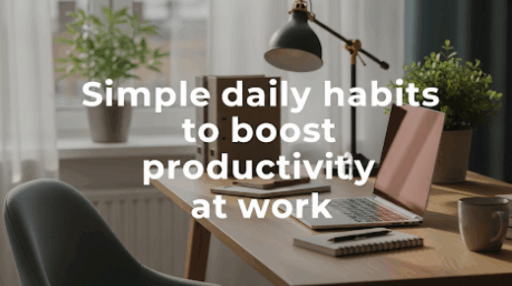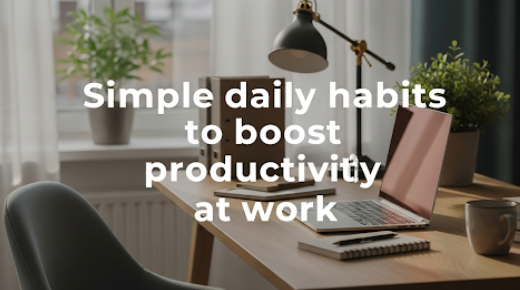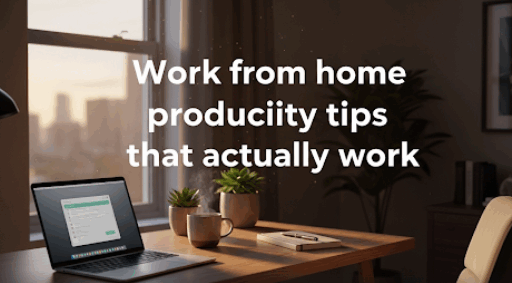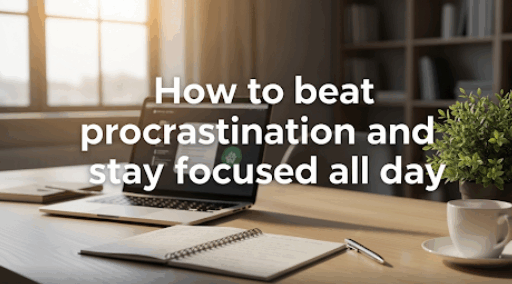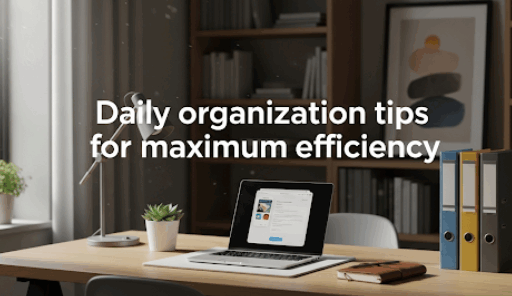In Just Minutes This Is How to Transform Your Workday: Daily Habits to Uplift the Productivity of the Day
You do not need sophisticated apps or life hacks to get more done at work. The secret is small daily actions that will lead to change over time. If you feel that your mailbox is flooded, if you think there are not enough hours in the day or if your tasks overwhelm you and keep accumulating, read on to find out how daily routines can revolutionize your professional life.
Many people believe that productivity means working longer hours or just pushing yourself harder. That’s a myth. True productivity is in your brain; not your brawn. These habits are things that take up less than 5 minutes of our day but have a very lasting effect.
Studies have shown that the most productive people in any field are not unique, they just use better habits. Here is how that works, and here are a few proven strategies you can use to do more and feel calmer and more in control at work.
The Morning Routines That Will Supercharge Your Day
Waking Up Before The Rest of The Planet Does
Early morning turns over an hour of golden, uninterrupted concentration. Getting to work 30 minutes early or commencing your remote work experience before anyone else in your household was one of the few opportunities you could have to:
- See your priorities for the day without distractions
- Do your most difficult task when you are the freshest
- Answer Time-Sensitive Emails Before The Back-to-Back Meetings Hit
The entire day must be in a calm and purposeful tone.
Pro Tip: This is your quiet time so do the deep work that needs some concentration and focus in here. Morning is when the willpower center of your brain is at its peak, which makes it ideal for complex or creative tasks not just menial soul-sapping drudgery.
Create a Personal Launch Sequence
As pilots adhere to pre-flight checklists, so too do high performers. Your personal launch sequence should last 10–15 minutes and consist of:
- Organized workspace in a hurry: Clean your desk and stack some necessary things
- Quick check-in: Open your calendar and task list for the day
- Identify your energy level and work around it
- The benefit of setting an intention is simple: you pick your top 3 non-negotiables
It is a routine that fosters mental clarity within your day and does not immediately thrust you into reactionary mode where everything appears to be other people’s priorities not your own.
The Two-Minute Energy Boost
Do something that excites you for two minutes before going to work:
- Stand by an open window and breathe deeply five times
- Light desk stretches
- Put in your earbuds or headphones and play one favorite song
- List three things for which you are grateful
- Review your long-term goals
While this may seem like an insignificant amount in terms of cost, the return on your investment is a million-fold in return as I will be so much more focused and motivated throughout the day.
Productive Strategies for Managing and Approaching Your Work
Daily Big Three
Instead of driving yourself crazy with endless to-do lists, pick three essential things that will take your work much further. These should be:
- Outcome-oriented: Things that genuinely get you closer to your goal
- Timed: It can be done in your shift
- Specific: Focused goals instead of general aims
Write it on a sticky note and place it somewhere you can see. Everything else becomes secondary. This saves you from task paralysis and guarantees, though always moving steps towards your goal.
The Best Friend of Your Schedule: Time Blocking
By time blocking, like your days are organized and you will be a lot more efficient throughout the day. How to apply it effectively:
Morning Block (9:00-11:00 AM)
- Deep work and complex projects
- Creative tasks requiring focus
- Important writing or analysis
Midday Block (11:00 AM-1:00 PM)
- Meetings and collaborative work
- Email responses and communication
- Administrative tasks
Afternoon Block (2:00-4:00 PM)
- Follow-up tasks and project completion
- Planning for tomorrow
- Less demanding routine work
Buffer Block (4:00-5:00 PM)
- Unexpected tasks and interruptions
- Email catch-up
- Workspace organization
The 25–5 Rule of Energy
25-minute focused sprints work, 5-minute breaks. This technique avoids mental exhaustion, keeping you productive all day long is a form of Pomodoro.
During your 5-minute breaks:
- Stand up and move around
- Look away from your screen
- Take deep breaths
- Hydrate with water
- Do not use social media or email
Every 4 sessions, have a longer break of around 15-30 minutes.

Communication Habits That Save Hours
Three Easy Rules – Master Email
Email… your greatest asset which can be the biggest productivity sapper. Follow these three rules:
Rule #1: Only Check Your Email 3 Times A Day
- Morning: Check for the urgent stuff (30 seconds)
- Noon: Schedule and respond to all urgent communication
- End of day: Cleaning up, planning for tomorrow
Rule 2 — Apply the Two-Minute Rule: If an email takes two minutes or less to handle, get it out of the way right now. If it takes more than 2 minutes, then schedule a special time for the task or delegate it.
Rule 3: Subject Lines that are informative, succinct, specific
- “Action Required: Budget Approval Needed by Friday”
- “FYI Project Update — no response necessary”
- “Quick Question: Preferred Meeting Time?”
Maximum Meeting Efficiency for Everyone
Turn your meetings from slack-time into time management optimizer:
Before the Meeting:
- Provide an agenda 24 hours prior to meeting
- Set clear start and end times
- Invite only essential participants
- Prepare specific questions or topics
During the Meeting:
- Start and end on time
- Stick to the agenda
- Take notes on action items
- Set clear deadlines and next steps
After the Meeting:
- Post a recap in an hour or less
- Thoughts, actionable and who
- Set follow-up dates if needed
How to Say No Like a Grown-Up
The way around it is to protect your time, and you do this by setting diplomatic but firm boundaries. Use these phrases:
- “I would love to but I have other priorities this week. Maybe we should come back to it in a month?”
- “That sounds cool, but it’s not what I’m working on now. Did you ever ask [apparently relevant person about the topic]?”
- “I’m currently booked and unavailable to work on anything new at the moment, but I’d be happy to refer you to someone who could be a great fit for this.”
Workspace Organization for Mental Clarity
The Clean Desk Philosophy
As they say, a cluttered desk leads to a cluttered mind. Implement these organization habits:
Daily Reset (five minutes before final leaving)
- File or discard all papers
- Return any supplies to their proper place
- Clear your computer desktop
- Prepare tomorrow’s priority items
Weekly Deep Clean (15 minutes on Friday Afternoon)
- Organize drawers and storage areas
- Update filing systems
- Clean computer files and folders
- Review and discard outdated materials
Digital Organization Systems
You may have a completely clear desk, but your computer desktop and file systems are not exempt from this responsibility.
Folder Structure That Makes Sense:
Projects/
├── Active Projects/
├── Completed Projects/
├── Templates/
└── Archive/
Reference/
├── Procedures/
├── Contacts/
├── Resources/
└── Training Materials/
Email Organization:
- Use folders for different projects/clients
- Filters to organize mundane emails automatically
- Archive completed conversations
- Keep your inbox under 20 messages
The Power of Visual Reminders
Keeping you on track with visual cues in all the right places:
- List of priorities: Post to your desk or computer
- Deadline calendar: A round-up of the best dates to keep in mind
- Motivational pictures or quotes
- Routine checklists: For the normal tasks you already do and have to finish on a frequent basis
Energy Management Throughout the Day
Feed Your Body, Feed Your Productivity
Your performance at work is affected by what you eat, and drink:
Morning Energy Foods:
- Eggs, Greek yogurt or almonds are some of the protein-based breakfast options
- Think carbs (oatmeal, whole grain toast)
- Sweet and vitamin-rich fresh fruits
Afternoon Crash Prevention:
- Tuna on rye bread and mixed leaves with fruit juice
- Avoid heavy, processed foods
- Drink water, not just coffee
- Good examples are almonds, an apple or berries
Strategic Caffeine Use:
- 90 minutes after waking (upon cortisol levels falling)
- Stop caffeine at 2 PM for optimal sleep
- Green tea — Wake up with an energy that lasts without the crash
Movement Breaks That Energize
Sitting all day zaps your energy and makes it difficult for you to focus. Incorporate these movement habits:
Hourly Mini-Breaks (2 minutes):
- Stand, reach your arms up overhead
- Try desk push-ups
- Go to the water cooler or bathroom
- Roll your shoulders and neck
Midday Energy Boost (10-15 minutes):
- If possible, go for a walk outside
- Climb stairs in your building
- Do jumping jacks or stretches
- Practice desk yoga poses
Power Napping for Peak Performance
Power Nap: Depending on if your job allows, 10-20 minutes napping in the afternoon really boosts productivity.
- Find a quiet, dark space
- 20-minute timer
- Cover your eyes with a sleeping mask or close your eyes
- Try to relax, even if you do not manage to fall asleep
If a nap is not doable, take a “quiet break” — rest with your eyes closed and deep breathe for 5-10 minutes.
Technology Tools That Enhance Focus
Apps That Block Distractions
Combat the distracting power of technology with technology:
Website Blockers:
- Social media blocking during business hours
- Cut out news sites that mess you into rabbit holes
- And here is one more deal, so you know that your workers at work are visiting entertaining sites — very regularly!
Phone Management:
- “DO NOT DISTURB” for deep work sessions
- Hide your phone in a file drawer or another room
- It helps you prevent getting lost in your phone, and it is a great way to create focus modes
Notification Control:
- Turn off non-essential app notifications
- Schedule time for inboxes
- Email scheduling helps you stay out of non-working hours
Productivity Apps That Actually Help
Pick tools which solve basic things:
Task Management:
- Todoist for comprehensive task tracking
- Any.do for easy on the eyes wishlist
- Trello for visual project management
Time Tracking:
- RescueTime for automatic activity monitoring
- Toggl for manual time logging
- Clockify for team time tracking
Note-Taking:
- Notion for all-in-one workspace organization
- Evernote for storing and grabbing your docs
- Quick note-taking app
Calendar Optimization Strategies
Your calendar should serve you, not the other way around.
Color Coding System:
- Red: Immediate deadlines or key meetings, etc
- Blue: Deep work & focus period
- Green: Routine tasks and administration
- Yellow: Professional development and learning
Buffer Time Management:
- Add 15 minutes between meetings
- Account for travel time to off-site appointments
- Block out extra time in your schedule for errands and anticipate the unexpected
- Integrate time for preparation before key meetings
End-of-Day Routines for Tomorrow’s Success
The Five-Minute Future Self Setup
Take five at the end of every work day to get ready for the next:
- Organize your workspace: File documents and organize supplies
- Check previous tasks performed: Reflect on your wins for the day
- Write out your Big Three tasks for tomorrow
- Take a look at your calendar: Notice any urgent meetings or deadlines
- Set intention: What energy do you want to bring to tomorrow and what areas will get your focus
The routine serves as a close for the day and reduces the time it takes to get started tomorrow.
Weekly Planning
15 minutes on Friday — plan the next week out this would look like:
Weekly Review Questions:
- What were the biggest wins for me this week?
- How did I struggle, and how can I do it better next time?
- What are the critical things that need to be done next week?
- How can I improve my productivity processes?
Weekly Setup Tasks:
- Block out the time for your Big Three tasks every day
- Block time for important projects
- Plan any necessary preparation work
- Identify potential obstacles and solutions
Boundary Setting for Work-Life Balance
Work time and personal time are as sacred for the productive person:
Digital Boundaries:
- Check your email only during specific hours
- Either use a separate device or the same device with separate accounts for work and personal use
- Family time is not work time — disable work notifications
- Differentiate between work and where you lay your head
Mental Boundaries:
- Try to keep work issues at work
- Do something that really makes you use your brain
- Seek out hobbies which are unrelated to your work
- Treat sleep like a non-negotiable productivity tool
Productivity Metrics That Matter
Tracking Progress Without Obsessing
Track your productivity through basic KPIs:
Daily Tracking (1 min each day)
- A lot of Big Three tasks completed
- Energy level on a 1-10 scale
- Work session focus
- Overall satisfaction with the day’s work
Weekly Analysis (5 mins)
- Percentage of planned tasks completed
- Energy and focus patterns
- Most common productivity obstacles
- Successful strategies worth repeating
Quality vs. Quantity Measurements
Outcome vs Activity:
Quality Indicators:
- Projects that are on-time and on-budget
- Gratitude from co-workers or customers
- Less stress in busier times
- Improved work-life balance satisfaction
Avoid These Vanity Metrics:
- Hours worked (more ≠ better)
- Number of emails sent (better communication over more material)
- Total meetings participated in
- Tasks completed (busy ≠ productive)
Building Long-Term Productivity Success
Small Shifts + Consistency = The Compound Effect
Habits are the compound interest of productivity — the same way that money multiplies through compound interest, the effects of your habits multiply as you practice them day after day. 1% better every day = 37x better in a year.
Month 1: Master mornings & tidy up workspace
Month 2: Integrate time blocking & strip out the fluff in your days that don’t add to money or mission
Month 3: Upgrade energy & add movement — monthly breaks, better sleep, regular movement, naps, walks and dance-offs for rejuvenation, amped creativity and productivity
Month 4: Stabilize tech habits — no email with a task bar; one tab at a time; outcome-oriented/income producing activities
Creating Accountability Systems
Sustainable productivity requires accountability:
Self-Accountability:
- Keep a simple productivity journal
- Systems review and adjust on monthly basis
- Celebrate small wins and progress
- Learn from setbacks without self-criticism
External Accountability:
- Share your goals with a colleague you know you can trust
- Join an accountability group for productivity or create one
- Work with a mentor or coach
- Use tracking apps
Adjusting Habits That Work for You
The greatest productivity system is the one you actually use regularly. Tailor these habits to you:
- Work environment: Remote / Office or hybrid
- Role requirements: Creative/analytical/interpersonal
- Individual energy patterns: Early bird or late riser
- Personal life: Family obligations, commute time, health concerns
Conclusion: How to Gain More Free Time
You don’t need extreme changes or superhuman willpower to transform your working life. These are easy, practical and scientifically-backed routines that you can follow as well. Consistency is what matters the most, not perfection.
Choose one or two habits to begin with which will make the biggest difference for your most pressing concerns. Master those before introducing new ones. Remember, you are creating a sustainable system that can be applied whenever possible, not turning into an overnight productivity robot.
The small things you do today will become the big wins of tomorrow so your future self will thank you later. Every time you introduce a habit in your life, you are investing in a more ordered, concentrated and successful performance. The realization that these daily actions will compound and allow you to achieve much more while also reducing anxiety levels and feeling more in control is eye-opening.
Take the first step today. Pick a habit from this guide and commit to practicing it for a whole week. Let your journey to easy productivity begin now.
Ready to supercharge your productivity? Pick your first habit, and it starts tomorrow morning. Great change starts with small steps.
